The Air Transport Auxiliary had been formed under BOAC’s care as a totally civilian operation with the sole job of delivering aircraft around the country from factories or maintenance facilities to the airfields where they were needed. This was to prove vital and removed the need for Service pilots to be pulled away from their more important roles. Late in 1942, even before the Glider Instructor School moved out, officials from the Air Transport Auxiliary had been to Haddenham to assess its suitability for a new training school.
The ATA's pilots came from various sources. Some were civilian pilots
before the war, some were seconded directly from the RAF, some had no
flying experience at all. So it was necessary to form a training school
where pupils could be trained from scratch ‘the ATA way’.
The school
was initially started at White Waltham in Berkshire where the ATA had its
headquarters but things became very busy there so it moved to the small
airfield at Barton-le-Clay just north of Luton. However after only a year
things became difficult there also with the testing of various fighter
aircraft, as well as flights by new aircraft from the nearby Percival
factory, all going on at the same time. So it was decided to move most of
the operation, leaving just a few aircraft for initial pilot selection and
basic training.
The move to Haddenham was not without its difficulties, the biggest being that of billeting. Because the ATA was a civilian organisation things couldn’t just be requisitioned as by the military, so housing, cleaners, catering staff etc. all had to be found. Volunteers were called for from all over the ATA organisation from as far away as Scotland and some labourers were even hired direct from Southern Ireland. Initially two colonies of concrete huts left over from the GTS days were used for accommodation and the ‘communal feeding and social centre’, also vacated by the RAF, (now the site of the Public Library), was also used. There wasn’t even a canteen on the airfield so an empty hut was put to use as a temporary snack bar, which nearly vanished soon after when an Engineering Officer taxied a Fairey Barracuda into it! Senior members of the staff were eventually housed in one wing of Dinton Hall by kind permission of Sir William Currie, women members were housed separately in either Hopefield or Yolsum House.
After initial training up to solo standard at Barton, (travelling there
each day by bus), the pupils would return to Haddenham for lectures on
Meteorology, Navigation, Engines etc. before converting from the simple
Miles Magister to slightly more complicated aircraft such as the Percival
Proctor, Fairchild Argus, Fairey Swordfish or even Hawker Hart and Audax.
Once past this stage the pupil would be allowed off on their own usually
in a Magister to do a series of long cross-country flights which would
familiarise them with all of the hazards of wartime Britain, such as
Balloon Barrages, Forbidden Areas and major airfields. Following this
stage the pupil would be posted away to one of the Ferry Pool’s for a
month where he or she would act as general dogsbody ferrying empty light
aircraft about, (they were still not allowed to carry passengers at this
time). This would get them used to the procedures involved in ferrying as
well as give them extra experience without subjecting them or anyone else
to too much danger.
After the month was up the pupil would return to
Haddenham once again for training on more sophisticated aircraft, which is
where the ubiquitous Harvard comes in. This aircraft had all the
new-fangled complications a ferry pilot would soon be using such as
retractable undercarriage and variable-pitch propellers. If all went well
at this stage the pupil was converted onto the school Spitfire, usually a
tired Mk.Vb or similar, and then receive their Wings. At this stage they
were allowed to fly any aircraft in Class I, which was essentially any
single-engined aircraft from Walrus to Typhoon. Multi-engine training was
done at White Waltham. Co-located with the Initial Flying Training School
at Haddenham was No.5 Ferry Pool from where the new pilots would start
their regular ferrying with the single-engine fighters of the day.
Life
wasn’t a complete bed of roses at Haddenham even in the ATA. On September
2nd 1943 a Hawker Hart, (K6526), crashed on the approach to the airfield
and immediately caught fire. One of the Engineers on the field, Mr. E.
West was soon on the scene and despite considerable risk to himself was
able to extricate the pilot. Mr.West was awarded the ATA’s Certificate of
Commendation.
LIFE IN THE A.T.A.
J.B. Dorrington remembers his 10 months at Haddenham
with affection and much enjoyment. He was mixing with people from all over
the world, ‘from girls presented at Court to avowed Communists’ . His
Instructors were also a mixed bag, the first was a retired Bank Manager
who had flown in the First World War, (E.C. Mogridge), the second a commis
chef at the Dorchester and the third a society photographer for The
Tatler! (The latter was E.C.H. (Nobby) Pearmund who instructed on
Harvards.)
Haddenham wasn’t too bad a place to stay either, with
weekends off the pupils could at least take advantage of the several pubs,
as well as concerts held locally and easy access to Aylesbury or London.
He even recalls the ATA had formed a rugger team which although started
off inauspiciously eventually beat a team from the Highland
Division.
He started his training on October 6th 1943 and by the end of
1944 had flown 14 different types including Hurricane, Spitfire, Firefly,
Barracuda, Mustang and Swordfish and had covered the length and breadth of
the country.
Yvonne Macdonald also trained with the ATA at
Haddenham. The following is an extract from an e-mail she sent me:
"I
was still at school when the war started and was an RAF widow early in
1943 (my 22 year old husband was lost bombing Berlin and is buried at
Antwerp). I had no flying experience but applied to ATA and was accepted
for training during a short period when they took in a few 'ab initio'
applicants. My sister, Joy, also applied in 1943 and we ended up being the
only sisters out of the 240 females who served. I reported to Thame in
Sept.43, my sister was a couple of classes behind me.
As far as I
remember we were admitted in groups of ten or twelve, and as you say,
bussed to Barton every day for flying instruction. We were given 12 hours
to solo, some were deemed unsuitable for various reasons. Safety was
stressed and later when we were delivering fighter aircraft to squadrons
we were aware that any accident or incident that could be traced to our
lack of judgement or care would not be tolerated. The pilots in training
in my time were varied, a couple of Waafs, an American lady with lots of
experience who nevertheless had to learn our way etc....... After Barton
we returned to Thame to do cross country trips, sometimes with an
instructor as we still had a lot to learn. Somewhere in here we did a
couple of weeks ground school. We flew a small monoplane at Barton and
Thame, the Magister, it had a fixed undercarriage. I also flew my first
Tiger Moth here. For some reason reason we didn't use them for training.
You must remember we didn't fly every day because of the weather. Anyway I
first flew with an instructor on Oct 8th and flew solo on Nov 8th. Still
lots to learn tho', I remember I earned my wings on March 1st, exactly a
year from my husbands' death. Lots of time then on the Fairchild Argus,
our hard worked taxi aircraft........... I ended the war having flown
about twenty different types, a very modest amount as some of the
experienced women who were in from 1940 had well over 100 including 4
engines and jets. I was stationed at Cosford, Hamble and Sherburn, but put
in at all our pools from time to time".
Click here
for Yvonne's story brought right up to date!
June Gummer (nee
Howden), Whangarei, New Zealand.
(In correspondence with Wg.Cdr Alan
Watkins, August & September 1999
I started training in
Jan/Feb 1944, having been in the New Zealand WAAF and released to see if
the ATA would accept me, travelled over at my own expense (i.e. I
reimbursed my father post-war for my fare - he believed in ‘paying your
own way’). I had won a newspaper’s flying Scholarship whilst at boarding
school at Hamilton in 1935 when I was 17, where I had about 50 hours of
dual and solo, but hadn’t flown for a few years - the confidence of youth
is amazing!
The reception ‘Security’ Committee at Liverpool was very
suspicious, especially re my address book having so many airmen pilots’
addresses and Von Eckner (I collected ‘aviators autographs’)! They told me
there was a war on and I would probably be sent to work in a munitions
factory.
A NZ Sq/Ldr was told to be responsible for my authenticity - I
had forgotten that I had a letter from our Minister of Air, probably in my
trunk in the bowels of the ship. However, the 200 Pall Mall cigarettes I’d
picked up in New York passed OK. “You’ll probably smoke all these before
you land?” “Oh, yes!” Actually, I didn’t smoke; they were for gifts.
We
did initial training on Miles Magisters at Barton-in-the-Clay, travelling
daily from Haddenham by an ATA bus. Ground school was at Haddenham,
conversion on to Harvards and Spitfire and, later, Oxfords at
Haddenham.
Yes ... That first Spitfire was quite something!! It was a
Spit 5; I beat up Hartwell Camp (very mild beat up) and up-up to the
clouds, levelled off and there were black puffs from the exhausts and
bangs. “Oh my God, not a forced landing surely?” I’d forgotten that the
5's didn’t have injection carburettors! All was well and I made lots of
what my instructor called “graveyard approaches” but good landings, until
the control wanted to go home and called me in with red Aldis lamp
signals.
A Mr Rose, a carpenter, in Haddenham, made me a gadget for me
to strap on my knee for Nav purposes but I don't think I used it much in
the end.
After Thame I was posted to Cosford and when Cosford closed to
Hamble until ATA was disbanded. I ended up with about 22 types in the
logbook.
Derek Blaise, Frinton-on-Sea (In correspondence with Wg.Cdr Alan Watkins 8/7/99)
I qualified as
an RAF pilot in Canada in Dec 43. On returning to the UK I was at once
redundant for, thank God, aircrew losses had much diminished and a surfeit
of pilots existed. Fortunately a small number of us were seconded to ATA
at No 5 Ferry Pool for ferrying tuition.
In a nutshell, we were taught
to memorise a standard cockpit drill, thus locating the knobs and bits
which, coupled with the data in a ringed handbook, enabled us to fly any
type within our category, of which there were five: Single engine, Light
twin, Heavy twin, 4-engined, and Flying Boats.
I was on Single-engined
ferrying, mostly to M/Us. So you will see that I was not a typical pilot.
The old stagers were mostly pre-war, fairly comfortably off men and women
with a love of flying and already qualified pilots.
On a lighter note,
I recall an incident which might amuse you. One day I had to collect a
Barracuda from a Naval station. A Lt Cdr asked for a lift. This was not
allowed but I told him to hop in and keep quiet. As I tucked him in before
shutting the canopy he said, “Do you know, old boy, this is the first time
I’ve been in one of these”. “Me too”, I said. I can see his face now. But
he stayed put. Probably thought that I was joking, but I wasn’t.
Daphne Rumball, Victoria, British Columbia. (In correspondence with Wg.Cdr Alan Watkins, 10/4/2000)
I look back on my two years
with the A.T.A with fond memories - demanding, exciting, sometimes
terrifying, but mostly I remember the friendships I made and the wonderful
people I was lucky enough to meet. My connection with Haddenham and Thame
is twofold. In 1940 my application to join the W.R.N.S. went unanswered,
the firm I was working with at Ramsgate moved away ‘for the duration’, my
mother decided (as things were getting rather ‘lively’) to stay near my
brother in Thame for a few weeks - so I joined her. I immediately got
another secretarial job with Hordern-Richmond on the edge of the airfield
at Haddenham. With ‘digs’ in Thame, I spent the next two years with them,
cycling back and forth most of the time, then moved to their Princes
Risborough office. After a few months there, I happened to see an ad for
‘pilots in A.T.A.’ and, on the strength of going solo and having a few
hours on a Tiger Moth with the Civil Air Guard at Ramsgate Airport in 1939
(which is now ‘housing’ I think) I applied - and to my great astonishment
was accepted! I survived 1 F.T.S. at Luton and Barton-in-the-Clay,
learning to fly all over again in a Miles Magister, and then was somewhat
shocked to discover we were being sent to Thame now No 5 E.F.T.S. (“Oh -
it’s near Aylesbury” they said!).
Unfortunately, my efforts to control
the Hawker Hart were not sufficiently good to go on to the Harvard and
Class II aircraft (Spitfires etc) so I expected to be ‘scrubbed’ at once.
But I managed to fly a Percival Proctor (with a variable-pitch air screw)
to the satisfaction of two incredibly patient instructors, and after
‘secondments’ to Cosford and Hamble, I spent the spring and summer at
Thame in 1944, mostly doing ‘taxi’ work with the Fairchild Argus and the
occasional Class I ferry job. Then to No 1 F.P. White Waltham in July,
until I left A.T.A. in May 1945.
One of my brothers joined the
R.A.F.V.R. in 1939 but was tragically killed in a Spitfire accident in
November 1940 (with 610 Squadron at Acklington). The other brother (older)
was teaching at Lord Williams School in Thame (and doing Observer Corps
duties) until 1942, when he joined the R.A.F. as an Intelligence Officer,
first doing Photo Interpretation, then with Squadrons at Tangmere, then to
Denmark until the end of the war. He returned as Senior Master at Lord
Williams after the war. He died in 1983 and the brothers are now buried
together in Thame churchyard.
W.H. Aldrich, Weston-Super-Mare. (In correspondence with Wg.Cdr Alan Watkins, 20/10/99)
From OTU I went on to an
HCU at Sandtoft or as it was popularly called Prangtoft for obvious
reasons. It was here that on my second solo in a Halifax I did a spiral
dive into the deck from 800 feet. This resulted in my appearance before an
Aircrew Re-selection Board which decided that as I had proved to be
inefficient on one type of aircraft and the Air Force has no room for
inefficient pilots I could become a bomb-aimer or transfer to Air
Transport Auxiliary. As this was mid 1944 the thought of flying with an
even bigger clot than myself hardly fitted my personal survival plan so I
elected to go to ATA.
Haddenham or Thame to give it the RAF name for
the airfield was the Initial Flying Training School for ATA and was
designed to train potential ferry pilots to be able to fly all single
engined planes with the exception of Tempests and Typhoons. These u/t
pilots as I recall were all women and given the rank of cadet whereas the
RAF pilots of whom there were about six or seven sergeants and myself and
another flight lieutenant were all classed as Third Officers.
I believe
there was some sort of hostel accommodation but five or six of us to save
money decided to sleep in a Nissen hut across the road from the airfield
where there was a canteen.
All trainees, T/Os and Cadets, were given
the same very excellent training in both the classroom and in the air. Map
reading was most important since ferry pilots had no radio and only a
compass and a map as navigational aids while coping with a strange plane
in poor visibility caused by the dark satanic mills working flat out for
the war effort. Stress was laid on the types of landmarks that could be
relied upon and how the shape of lakes could change with flooding also
forests could change. The most reliable guide was Bradshaw’s Iron Beam
namely the railway. The dangers of pressing on in bad weather could not be
over emphasised. As Air Force pilots we had a lot of training on
instrument flying but flying in cloud without knowing what is in it and
below it could be fatal. We were also taught acronyms to cover pre flight,
take off and landing drills to cover all types of planes we would be
qualified to fly.
Our flying training started in Magisters at Barton
airfield. The Magister was an open cockpit two seater low wing monoplane
fitted with brakes and flaps. A Tiger Moth biplane without brakes or flaps
was used to demonstrate stalling, spinning and sideslipping.
After the
Magisters came the Proctor a four seater saloon type plane with a two
pitch propeller, brakes and flaps together with a boost gauge. This was a
welcome change as it was now November 1944. It did not last however
because by December we were back to the Magisters and doing cross country
flights. In fine weather they would have taken a maximum of three hours to
complete, as it was, such a trip took me on one occasion four days, and it
had been known for one trainee to have taken three weeks.
The next move
according to my log book was conversion to type namely the Argus, an
American high wing four seater monoplane which was also known as a
Fairchild. It was used to take ferry pilots to and from their
destinations. The conversion did not take long and we moved on to the next
type.
This was a Harvard another American aircraft and not one of my
favourites. A two seater enclosed cockpit with a variable pitch propeller,
flaps and brakes. It had a complicated starting procedure and no automatic
boost control. This was the final hurdle before flying the Spitfire. To
make it as realistic as possible to the Spitfire the Harvard was flown
from the back seat. The restricted forward visibility required a landing
approach to be on a perpetual curve and taxying in a zigzag.
Prior to
our first flight in the Spitfire it was impressed upon us the need to
effect the change-over of pilots as quickly as possible as on the ground
the engine could quickly over heat. This was because one strut of the
undercarriage blocked the oil cooler intake. Well came the moment and I
hastily squeezed myself into the cockpit, strapped on the Sutton harness,
selected fine pitch, rich mixture and brakes off. I opened the throttle
with my left hand while holding the joy stick with my right. There was a
sound as though the hounds of hell were behind and the plane speeded its
bumpy way over the grass towards the far boundary. Airborne I selected
undercarriage “up’ this affected the smoothness of the take off because I
had to use my right hand to operate the lever. Distracted by being unable
to close the hood I failed to notice the undercarriage although selected
had not in fact retracted. The instructor was not best pleased. However
after a few more circuits and bumps I got the hang of it and was checked
out as a Class 2 pilot and qualified to fly any aircraft except a Tempest
or Typhoon.
At the time my home was in Bristol so I was happy to take
the opportunity of a ride in an Argus that was going to an airfield just
outside Bath. The pilot was an attractive cadet who was reputed to be a
Pacific island princess. I declined her offer for me to take the controls
and said I would map read. Reaching our destination we found jets were
using the out of wind runway. It was quite windy and I suggested we should
use the runway that was into wind. However she ignored my advice and, give
her due, made a text book touchdown which was subsequently marred by a
gust of wind catching the underside of the port wing and tipping the plane
on its side. The result was I found myself half out of the aircraft with
her on top. No injuries but it would have been quicker to have gone by
train in view of the time spent on report writing. Although I did not sign
the Form 700 which would have made me captain of the aircraft nevertheless
as usual I got the blame.
ATA pilots could be expected to ferry any
type of plane that came within their classification and that could amount
to dozens. Accordingly we were issued with a thick note book containing
essential details of every RAF aircraft. This allowed pilots to check what
to do before take off and while in the circuit preparatory to landing.
Having been given a Barracuda to ferry from Wroughton to Kirkbride and
confronted with this somewhat weird looking aircraft I discovered the one
thing the book did not mention was how to get into it. For this I had to
ask the ground crew.
When I was at Central Gunnery School there were
times when one of our aged Wellingtons was required to go to a Maintenance
Unit but because it was a borderline case it would be left for ATA to
collect. Little did I think I would be on the receiving end of such a
practice. On more than one occasion I have had to collect a plane parked
at some remote dispersal point adorned with placards recording the absence
of various parts. Delivering a fighter was something of an embarrassment
since if another fighter was in the circuit the pilot would usually want
to play games despite attempts to wave him off. On one memorable occasion
I had a Spitfire IX, a more powerful model than the Spitfire V I cut my
teeth on. This was to be taken from Cowley to Cosford. The airfield at
Cowley was surrounded by buildings which gave the impression of it being
smaller than it was. The plane had been on dispersal for sometime because
when I took off my forward vision was completely cut off by a cascade of
water coming from the nose. Safely airborne I decided to follow the
railway line to Bristol and follow the Severn Valley to Cosford. Just as
well because no sooner had I started than the constant speed unit on the
propeller started to leak making forward vision impossible. As a
precaution I throttled back but even so the speed was still 120 MPH. I
eventually landed at Colerne for repairs, which happens to be near
Bristol.
Edward Henry
Robinson.
John Robinson wrote to me regarding his
father who served in the ATA from 1941 to 1945 on secondment from
BOAC. (He can be seen as the eighth person in the group
photo of ATA staff on the right of the page).
"My father was on a mission
to create and implement Planned Maintenance and improved
familiarisation techniques in aviation, since his early days as a
shipbuilding engine apprentice in 1918 then joining the RAF and being
posted to Iraq and India.
He joined Imperial Airways in 1928 and was
there at all the major events during the Empire Routes expansion
being posted then as Resident Inspector at Short Bros. in 1936, then
re-posted to open Hythe Base and back again to Shorts. He became the
nucleus of training at Hythe for Engineers and Pilots which continued
later at Whitchurch. Following a short period in Canada at
the inception of ATFERO he was posted to ATA as a Technical
Instructor (First Officer then later Flight Captain).
Right at the
start of his posting with ATA he implemented a quick and simple
familiarisation booklet for pilots based on extensive knowledge gained on
aircraft engines from his early days with Imperial and his subsequent
training experience - these became known as the 'Ferry Pilot
Notes'.
At the time the photo you show on your site was taken my family
were living in a caravan purchased by my father in the field of a
local Thame farmer after having lost their flat at Piggotts Hill.
My
eldest sister and two brothers attended the local catholic school, my
brother Peter still remembers being given an instruction on cockpit
instrumentation in a Procter at the airfield, something that he has
retained throughout his own years in aviation, having recently retired as
Chief Engineer of an Australian Airline, I also have been an aircraft
Design Engineer on Military and Civil aircraft such as Airbus mainly due
to my encouraged interest in aviation.
MEMORIES OF HADDENHAM
June Gummer (nee Howden), Whangarei, New Zealand, August & September 1999 Mr & Mrs Perkins
ran the grocery shop. Mr Hulme was stationmaster of Elmer’s Halt.
Stationmaster Hulme invited me to come and sit by their fire, which was
kind of him, but somehow I never managed to do so. Dr & Mrs John
Patterson invited many of us to play tennis on their court, any
evening.
I recall a woodpecker working on a Hopefield House tree and a
wren which built a nest under my window at Hopefield House; children
bringing out their whipping toys and the tinkle of the Perkins’ shop door
bell; the plovers on the airfield - one dented the wing of my Fairchild
Argus’s wing on takeoff towards the railway line. It wasn’t a large field,
but it sufficed.
Yolsum House was used as billets, across the road from
the canteen and offices, near the airfield entrance.
Margaret Morrison,
the authoress of romantic novels, was our Medical Officer. She wrote 'Paid
to be Safe' around an ATA girl pilot, ficticious character.
From a
letter home dated April 28th 1944 - "Jimmy and I went cycling last evening
and saw a fair which opens tonight. Roundabouts, swingboats, shies, steam
roller, caravans and a tower to slide down. It was not allowed onto the
village green until after the evening service". (Jimmy was killed in a
Seafire 15.11.44).
Jean Mcpherson and I were stuck in a window
waiting to see a Doodlebug go overhead at Yolsum House; the village
‘imminent warning’ had sounded. I said “What’ll we do if it stops?” Boom
boom boom, getting louder. LOUDER!! “I don’t know, perhaps we’d
better throw ourselves down in the corridor... !“ Then we realised it
had stopped! So... into the corridor, where we squatted down,
giggling nervously to a ZZZZZ noise. Someone on the road at the time said
it was about 600 to 800 feet overhead. It didn’t topple its gyros - it
glided on to hit Brill on the Hill. Post-war I met Annette Evill, daughter
of Air Vice-Marshal Sir Douglas Evill, Senior Staff Officer at Fighter
Command. She said “That was the one that broke all our windows in Brill.”
Small world.
The Crown and the Red Lion were the pubs. We used to
celebrate having “Spat” (i.e. flown the Spitfire) at the Red Lion or The
Crown, where the locals rather felt put upon at having their pubs crowded
with off-comers! However, they accepted our presence with good grace. The
New Zealand contingent based at Hartwell Camp, near Aylesbury - Col
Truesdale, Rev Harry Taylor (who had shared a caravan in Italy with my
brother, Peter Howden a medical officer in the NZ Expeditionary Force) and
Colin Wallace, son of the Postmaster in my home town of Waiuku, south of
Auckland and a school friend of my brother’s - all came over to help me
celebrate having flown my first Spit. They were in England to organise
repatriation of NZ POWs; small world again!
I just used the High Street
from Hopefield House and never really explored Haddenham, only the
surrounding countryside, and we usually went to London for days off. I
suppose we didn’t meet many locals as men of our generation would have
been in the forces, the women coping alone, and rationing didn’t encourage
hospitality. Things were abnormal, to say the least. ... Many Haddenham
women would have been working in some form of war service too. There was
no traffic, no petrol.
Jane Spencer, Baltimore, USA 17/1/2000
During the summer of 1944, I lived at Yolsum house, and a group of men cadets lived in a house on the south side of the village. We all ate at a mess, in the centre of the village. You may have heard how bad it was; almost everyone was ill at some time. About halfway along, toward the mess, where the road bent slightly, there used to be a tiny shop on the north side, where one could buy apples - real Cox pippins.
W.H. Aldrich, Weston-Super-Mare, 20/10/99
After fifty years some
memories tend to fade. For instance I was a civil servant yet I have no
idea as to what my fellow pilots did in civvy street, although there was
one young lad who used to sit cross legged on the crewroom table making a
hand sewn pair of trousers. For something to do we put on a concert in the
village hall but for the life of me I cannot remember what it was all
about.
Most of our pleasures were sought in London and decisions had to
be made as to which uniform, RAF or ATA, would be the most advantageous to
wear. Having had to surrender our 1250's it was a bit dodgey to wear RAF
uniform with only a civilian identity card to back it up.
I recall tea
dances with debutantes at The Dorchester and various other similar
functions we weedled our way into. One thing we did learn was after a
night out in town it was a crossed-leg journey from Baker Street to
Aylesbury in a corridor-less train!
For more than two years Haddenham was a very busy airfield,
probably busier than when the GTS was here, with no end of aircraft doing
circuits and bumps as well as setting off on training cross-country
flights and fighters such as Spitfires and Mustangs on their way to
operational squadrons.
By 1945 most of the work of the ATA had been done and there was certainly little need for any further training of new pilots. The ATA was gone from Haddenham by VE-day.
(You can learn more about the ATA by visiting the website of the Maidenhead Heritage Centre which has a major collection of ATA material.)
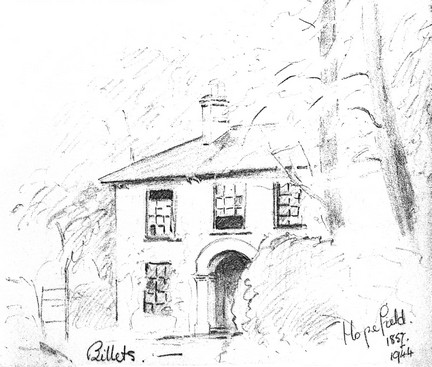
Hopefield House was used to billet the female members of the ATA whilst they were at Haddenham. (Sketch by June Howden, ATA 1944)
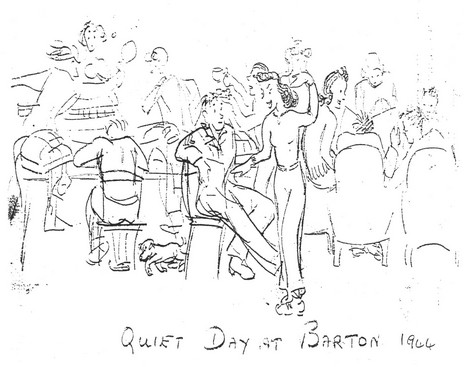
'Quiet Day at Barton', (Sketch by June Howden, ATA 1944)
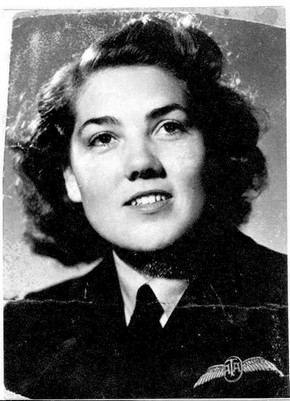
Yvonne Macdonald in A.T.A. uniform
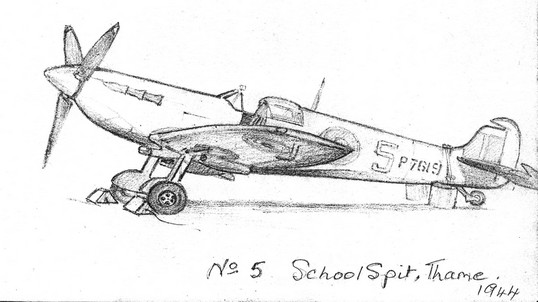
No.5 Ferry Pool Spitfire Mk.IIb, P7619. (Sketch by June Howden, ATA 1944)
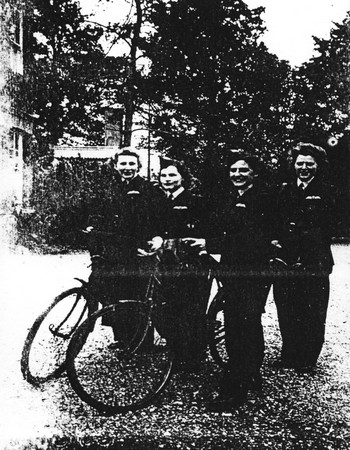
The photo shows Rosamund Everard Steenkamp, Jean McPherson, Monique Agazarian and Mary Guthrie.
“Rosamund
Everard Steenkamp was niece of Sir Lindsay Everard of Ratcliffe Hall, who
was President of the Royal Aero Club at one time. Ros was an experienced
pilot, her home was in South Africa. Monique Agazarian ran a Link Trainer
postwar, opposite Harrods in London. Before that she owned and operated
her own airline, Island Air Services, out of Heathrow and Croydon
Airports, I think to the Scilly Isles. Dominies I think she used. Mary
Guthrie married Jock Cunningham, a friend of my cousin in the FAA; Jock
was in the Navy, I think.
I’ve lost touch with Jean. Monique died last
year, I think - she had the sound of a Merlin engine at her funeral
service instead of a dirge - coming, passing, fading.” -
June Gummer, 1999.

(Sketch by June Howden, ATA 1944)

Staff of the Initial Flying Training School, Barton
in the Clay, 1944
L-R: Dennis Lead, Jack Marks, Hopkins, 'Bob' Ellis
(adjutant), Bill Cowan, Jerry Polivka, John Adams (seconded from RAF),
A.A. Ryner (engineer i.c.), Zuill (from Bermuda) and
Codlin.
Picture by kind permission of the Maidenhead
Heritage Centre
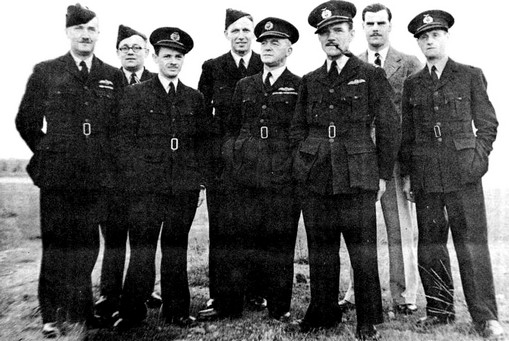
Thame 1943
L-R: 1st Off. Paull, 1st Off. Chappell, 1st
Off. Fazakarley, Flt.Capt. Sloper, Capt. Woods, 1st Off. Holloway, 2nd
Off. Gauntlett, Flt. Capt. Edward Henry Robinson.
Picture
by kind permission of the Maidenhead Heritage Centre
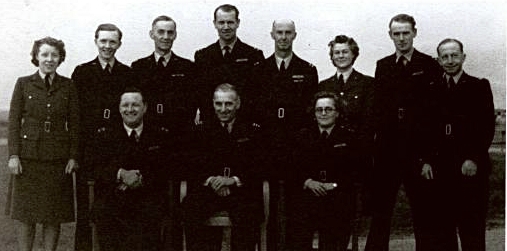
Senior Officers of No5 Ferry Training Pool, (date
unknown).
Back row - Section Officer Adams (Met office): Second Officer
Roy Hargreaves (Operations): Flight Captain H Vallé
(Operations): Flight Captain Frank Bourne (Flight Leader): Flight
Captain E.C. Mogridge (Flight Leader): Section Officer W. Simpson (Met
office): Flight Captain Jan Fossett (Flight Leader): First Officer Clark
(Signals Officer)
Front Row - Captain A.G. Head (Second in Command):
Commander Marc Hale (Commanding Officer): Flight Captain Susan Slade
(Officer in charge of women personnel)
Picture by kind
permission of the Maidenhead Heritage Centre

This Fairchild Argus was formerly FK330 of the
ATA and flown from Haddenham, (see Daphne Rumball's logbook).
It
now resides in Sydney, Australia and is currently being restored by John
Gallagher.
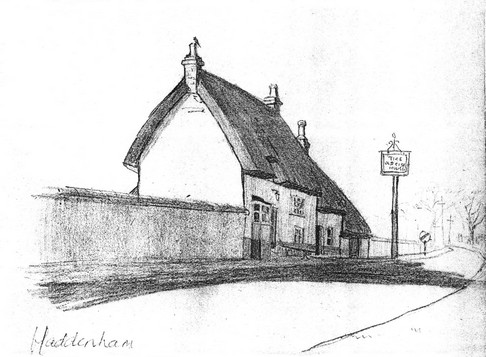
The Old Cider House - Haddenham.
(Sketch by June
Howden, ATA 1944)